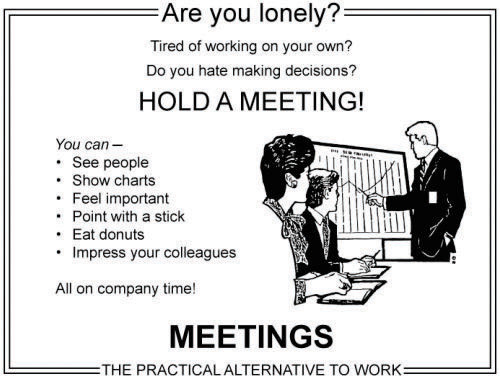This is “Groups and Meetings”, chapter 12 from the book An Introduction to Group Communication (v. 0.0). For details on it (including licensing), click here.
For more information on the source of this book, or why it is available for free, please see the project's home page. You can browse or download additional books there. To download a .zip file containing this book to use offline, simply click here.
Chapter 12 Groups and Meetings
PLEASE NOTE: This book is currently in draft form; material is not final.
Introductory Exercise
The OOCSIP (On-And-Off-Campus Student Involvement Project)
Rationale:
Educational, social, and recreational events take place on college campuses all the time. You’ve probably seen information about these activities and been invited to them. But have you ever attended a campus committee meeting or a community meeting whose members include college employees? Probably not. Thus, you may not understand how a college and its community function. This project will help you acquire such understanding.
What Students Should Gain:
- Contact with knowledgeable college professionals whose ideas and actions affect students.
- Appreciations for the nature and aims of campus and community groups.
- Knowledge about group dynamics—including formal processes.
- A chance to expose college employees to students’ circumstances and perspectives.
Steps Students Should Take:
- Identify an Employee Contact at their college or university who’s willing to meet them at or take them to two on- or off-campus events.
- Attend two (2) on- or off-campus events with their Employee Contact.
- Complete an Assessment of a Student’s Campus/Community Participation Form [Note 12.47], including the front page signed by the Employee Contact.
- Complete a typed Critique of Formal Campus or Community Gathering Form [Note 12.48].
- Send a hand-written thank-you note to their Employee Contact.
Once I ran across something in a book that really agitated me. The volume presented lists of ideas for living a happy and fulfilled life. One of the lists was headed “Five Great Ways to Find a Friend.” Its first four ideas were to find a cause, find a church, find a class, and find a club. All those ideas seemed reasonable to me. Recommendation #5, however, was “find a committee.” When I saw this, I immediately asked myself, “What were the authors of this book eating, drinking, or smoking when they wrote this? Who with more sense than a pencil eraser would suggest actually LOOKING FOR A COMMITTEE TO JOIN for any reason whatsoever?”
Phil Venditti

Are you lonely?
Getting Started
PLEASE NOTE: This book is currently in draft form; material is not final.
A college administrator we know overheard her seven-year-old daughter and another little girl talking about their parents. “What does your mother do?” asked the other child. “She goes to meetings,” replied the administrator’s child.
Whether in educational settings or business or elsewhere, meetings dominate the way many groups operate in American society. Estimates of the number of meetings that take place every day in our country range from 11 million to more than 30 millionhttp://www.studergroup.com/dotCMS/knowledgeAssetDetail?inode=269049. One authority claims that the average chief executive officer spends 17 hours per week in meetings, whereas the average senior executive spends 23 hours per week.Amos, J. (2002). Making meetings work (2nd ed.). Oxford, England: Howtobooks.
If the average number of people in each of these meetings is only five and the average meeting lasts only one hour, this means that between 55,000,000 and 150,000,000 person-hours each day are being consumed by meetings. Assuming a 50-week work year, then, the total time devoted to meetings each year amounts to at least fifteen billion person-hours. As for you, yourself, one estimate is that you’ll spend 35–50% of every workweek in meetings, for a total of more than 9,000 hours over the course of your lifetime.Doyle, M., & Straus, D. (1993). How to make meetings work: The new interaction method. New York: Jove Books.
If meetings are so central to what groups do, and so time-consuming, it makes sense to pay attention to how they’re conducted. Like any other course of action, the process of engaging in meetings has a beginning, a middle, and an end. In our first section we’ll consider the beginning—the planning part. Later we’ll look at techniques for facilitating a meeting, the use of Robert’s Rules of Order, and the best ways to follow up after a meeting.




